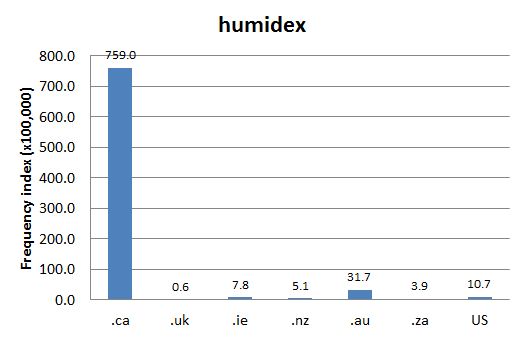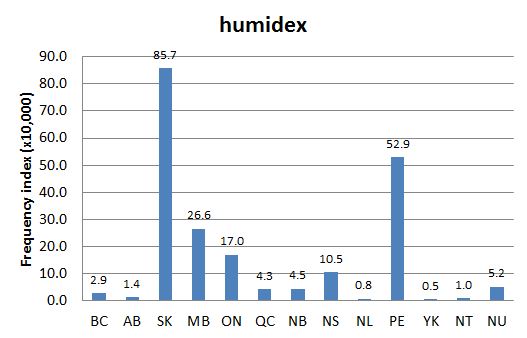DCHP-2
humidex Humidex, < humidity + index DCHP-2 (July 2016)
n. — Outdoors, especially Saskatchewan & Prince Edward Island
an index combining heat and humidity that takes into account the body's response to varying humidity levels; perceived heat.
Type: 1. Origin — When the humidity is high, people feel hotter because of the body's decreased ability to cool itself by sweating. Temperatures that would not stress the body when the humidity is low can trigger warnings to reduce exercise when it is high (see the 1998 quotation). Humidex was formed by combining humidity and index. The term is virtually restricted to Canada (see Chart 1). While Environment Canada (see reference) reports that the humidex formula is based on the work of J.M. Masterton and F.A. Richardson at the Atmospheric Environment Service (now MSC) of Environment Canada in 1979, the concept and term are older with quotations going back to Toronto in the mid-1960s. Chart 2 shows that the term has little importance on the Pacific coast, but is of special relevance on the Prairies (especially Saskatchewan) and on Prince Edward Island.
See also COD-2, s.v. "humidex", which is marked "Cdn", Gage-1, s.v. "humidex", which is marked "Cdn.", ITP Nelson, s.v. "humidex", which is marked "Canadian".See also: wind chill
- Often used in compounds, such as humidex indicator or humidex alert.
References:
- COD-2
- Environment Canada "Weather School: FAQ" Accessed 5 Sep. 2013
- Gage-1
- ITP Nelson
Images:
Chart 1: Internet Domain Search, 14 Aug. 2012
Chart 2: Regional Domain Search, 4 Feb. 2016

